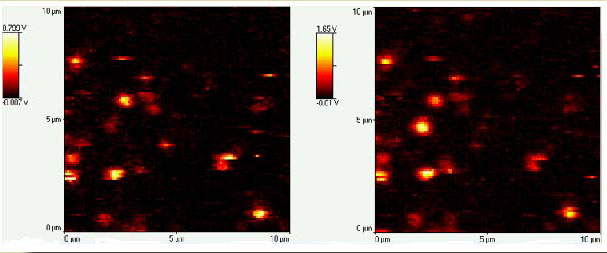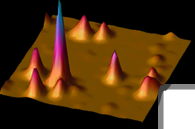FLUORESCENCE BEHAVIOR OF SINGLE-MOLECULE pH SENSORS
(Brasselet and Moerner, Single Molecules 1, 15 (2000))
The fluorescence behavior of a well-known pH-reporter molecule
diluted in an aqueous gel has been measured at the single-molecule
level. Single copies of the pH-sensitive seminaphthorhodafluor
SNARF-1-dextran were immobilized in the pores of agarose gels
at different pH in the range 6-9. This probe shows separate emission
wavelengths for its protonated and deprotonated forms, such that
the ratio between these two emission intensities is a signature
of the pH of the surrounding medium. Two-color confocal detection
of the time trajectories of single chromophore emission signals
allowed characterization of the behavior, molecule by molecule
(see Figure). In particular the distribution of the ratio between
the two emission wavelengths, measured over a large number of
individual molecules, shows a broadening at pH close to pKa,
which cannot be explained by the experimental noise. The observed
range of average ratios appears to arise from local inhomogeneities
in the environment of the fluorophore which alter the response
to local pH.

Figure: Two-color confocal images of single copies of
SNARF-1 dextran. The images (emission 580nm left, and 640nm right)
were obtained by scanning a 10m mX10m m
area at 10m m/s, resolution 100 pixels.
The integration time is 10ms per pixel, and 1V signal on the
scale corresponds to 100 photon counts. The images have not been
corrected by the detection correction factor. |



